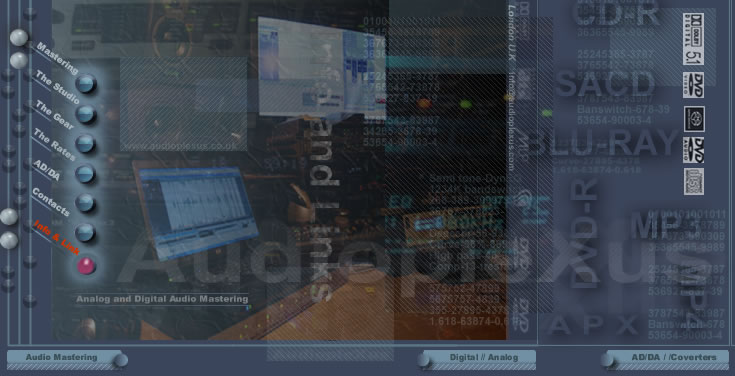
A CD is only a medium on which to store information; you can think of it as a very large, write-protected floppy disk. The difference is that, while DOS floppy and hard disks are written using the DOS file format, CD-ROMs are written using a standard format called ISO 9660. This standard is so widely accepted that it can be read back on any computer platform including DOS, Macintosh, and UNIX. This is one of the advantages of ISO 9660.
In an ideal world, you shouldn't have to think about ISO 9660 at all when you write a CD; there should be an operating system command similar to the DOS COPY command which would simply copy files from hard disk to CD. The world of recordable CD-ROM isn't ideal quite yet, so you need an entire software package to do the job. However, we've done our best to make it easy for you
CD Recordable This method of producing CDs uses a desktop recorder to put a premastered image on a disc that has a polymer dye layer, using a laser to burn the data into the dye. Recorders are available that work at single speed (76 minutes for 650MB of data or 74 minutes of audio/video including time to record leadout), 2x, 4x and 6x. 2x drives are the most common, requiring 39 minutes for a full 650MB disc
CD Replication This is the process of making a glass master from a premastered image, creating stamplers from the master, then pressing discs with the stamper using injection molding. Once the stamper is made and the machine is set up, a disc can be produced in a matter of seconds..
CD Duplication Duplication produces many copies of a disc at once. Duplicators use CD-R media, and usually a bank of recorders controlled by a single processor. The number of recorders that can be in a single array is limited by SCSI protocols, and usually cannot exceed 17 plus one reader for the source material.
Although Double Layer 8.5GB DVD-ROM and DVD video discs have been available for some time as part of the DVD read-only standard, it was thought impossible or at least improbable that a similar technology could be developed for personal DVD recording. However, Mitsubishi Kagaku Media (MKM), parent company of Verbatim Corporation, and Philips have recently proven that a Double Layer DVD recording system is feasible utilizing the DVD+R (write-once) format. This technology is named Double Layer DVD+R, or DVD+R DL. DVD+R DL hardware and media products will enable consumers to store up to 4 hours of DVD-quality video, 16 hours of VHS video quality or 8.5GB of data on a single disc—without having to stop and turn the disc.The development of reliable DVD+R DL media materials and manufacturing processes is the key technology enabler for Double Layer DVD+R recording. This white paper discusses each component of the DVD+R DL media structure and the challenges involved in producing compatible DVD+R DL media.The basic challenge was to develop materials and manufacturing processes for multi-layer DVD+R DL discs that allow the properties of two unique layers, once recorded, to meet the DVD read-only specifications for DVD-ROM drives and DVD video players. During recording (and reading), each layer can be targeted without disrupting data on the other layer (see Figure 1). The first recording layer (L0) of the Verbatim DVD+R DL disc is semi-transparent, providing enough reflectivity for writing/reading data on the first layer, yet transmitting enough laser power to read/write on the second layer (L1) by refocusing the laser.
Professional CD mastering is first and foremost a decision-making process, and then of course it's about making key changes to the sound. You can kind of look at a mastering engineer as a 'third ear’ guy, an over and above producer if you will. The mastering engineer comes in right at the end of a project and needs to make key decisions, and suggestions on the overall sound and layout (song sequences, pauses, etc.) that will be presented on an album. Producers, audio engineers, A&R persons, labels and artists all trust the mastering engineer to ensure that they put out a top sounding album with maximum impact. For this reason a mastering engineer needs more than just experience in audio engineering, experience in other aspects of the industry is vital. A mastering engineer not only needs a good ear, but also a good feeling for what works and what doesn’t, a good understanding and feel for different genres of music, a good grasp of how to make an album ‘flow’ from the first to last track, and much more.
This layer plays the important role of reflective layer for L0—but must transmit enough light to read/write on L1. To provide stable reflective and transmitted light, the thickness of R1 must be precisely controlled.
As a leading manufacturer of optical media which require thin metal film stacks like MO (magneto-optical) and DVD+RW, Verbatim/MKM have developed a special silver alloy material for semi-transparent properties and have tightly controlled thin-film uniformity by optimizing the metal sputtering process.The optically transparent layer between R0 and L1 is called the spacer. The groove for L1 recording is formed in the spacer layer and it is very important to minimize any noise caused by the spacer. Spacer thickness uniformity must be tightly controlled for clear recording on L1.Drawing on its experience as one of the largest material developers for optical discs, Verbatim/MKM applied a suitable material for the spacer and successfully developed a noiseless, uniform and transparent layer. Verbatim/MKM also developed a manufacturing process for application and stamping of the spacer layer